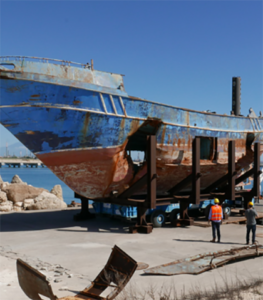Tragic migrant boat makes an artistic statement
A fishing vessel that sank off the coast of Libya four years ago trapping hundreds of refugees in its hull has become the poignant and thought-provoking centrepiece of th is year’s 58th Venice Biennale arts event.
is year’s 58th Venice Biennale arts event.
The art installation by Swiss-Icelandic artist Christoph Büchel is being exhibited in the Arsenale, the former shipyard and armoury that provided the Venetian Republic with its formidable naval power for centuries.
The Arsenale has recently been turned into an exhibition space for the Biennale.
Mr Büchel’s work is effectively the wrecked ship’s hull with the damaged hull clearly visible.
It has been named “Barca Nostra,” which means “Our Ship” in Italian, and a media release describes the vessel as “a relic of a human tragedy but also a monument to contemporary migration, engaging real and symbolic borders and the possibility of freedom of movement of information and people”.
The relic underscores “our mutual responsibility representing the collective policies and politics that create such wrecks”, the release says.
As many as 800 people are believed to have died in the capsizing of the vessel on April 18, 2015, when the boat, crammed with migrants, collided with a Portuguese freighter ship that had been called to its aid.
Only 28 people survived the accident, one of the deadliest shipwrecks in the Mediterranean in living memory.
The disaster accounted for nearly a fifth of the estimated 3,665 migrant deaths at sea in 2015, according to data from the International Organisation for Migration (IOM)
The Tunisian captain of the fishing vessel was later sentenced to 18 years in prison after being found guilty of charges including multiple manslaughter and human trafficking.
At the time of the disaster, Mr Büchel was working on a project for the 56th Venice Biennale: a working mosque inside a disused Venetian church.
The artist made headlines again last year when he created an online petition to preserve and have designated national monuments of eight prototypes for President Trump’s proposed border wall between the United States and Mexico.
The Biennale piece seeks to be equally thought-provoking.
In June 2016, the wreck of the fishing vessel was recovered from the seabed and taken to a NATO base on Sicily, where teams of forensic scientists attempted to identify the bodies of the victims trapped inside the hull
The wreck’s symbolic power was immediately apparent, and various proposals were put forward regarding its future use.
Italian media reported that film director Alejandro González Iñárritu wanted to display the boat in front of the Gothic cathedral in Milan to coincide with a visit by Pope Francis.
But a committee established to preserve the memory of the tragedy, gave Mr Büchel permission to use the vessel for an artistic statement.
The wreck was entrusted to the Sicilian city of Augusta, which formed a committee to find a space for it at the heart of a planned “garden of memory”.
The vessel will return to Augusta after the Biennale.
Laurie Nowell
AMES Australia Senior Journalist












